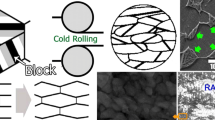Conclusion
The effect of strain-aging can be used as the fundamental basis for creating high-tensile austenitic steels. In such a treatment hardening is effected by the decomposition of the hard solution owing to high density of defects accompanying the formation of segregations of contaminated atoms and the separation of particles of the excessive phases. Here the intensity of achieving a high-tensile state is determined by the stability of austenite depending directly on the amount of martensite formed during the plastic strain process. The possibility of obtaining in the strain-aging steels unstable and stable γ-phase creates the conditions for controlling their properties within a wide range and makes possible their use as high tensile and relaxation-resistant materials.
Similar content being viewed by others
Literature cited
V. R. Baraz, "Strain aging steels for elastic elements," in: Structure and Physicomechanical Properties of Nonmagnetic Steels [in Russian], Nauka, Moscow (1986), pp. 45–49.
V. K. Babich, Yu. P. Gul', and I. E. Dolzhenskov, Strain Aging of Steels [in Russian], Metallurgiya, Moscow (1972).
V. F. Sukhovarov, Yu. A. Avazov, and M. A. Bol'shanina, "Investigation of strain aging of the N36Kh11 austenitic steel," Izv. Vyssh. Uchebn. Zaved., Fiz., No. 9, 54–67 (1967).
Yu. A. Skakov, "The effect of plastic strain on the decomposition of oversaturated solid solutions and the role of dislocations," in: Structure and Properties of Metals and Alloys [in Russian], Metallurgiya, Moscow (1970), pp. 19–35.
A. G. Rakhshtadt, Spring Steels and Alloys, [in Russian], Metallurgiya, Moscow (1982).
V. R. Baraz and V. V. Pokachalov, "Kinetic features of strain aging of the 13Kh18N10G32-S2M2 Alloy," Fiz. Met. Metalloved.,51, No. 5, 985–990 (1981).
A. P. Gulyaev and Ya. E. Sanchuk, "Formation of the martensite in plastic strain of steel," in: Scientific Papers of Universities, [in Russian], No. 2, Metallurgiya, Moscow, (1959), pp. 181–185.
V. R. Baraz, A. N. Makhan'kov, L. A. Maltseva, and C. V. Grachev, Stability of Austenite and Properties of Strain Aging Chromium-Nickel Steels [in Russian], Nauka, Moscow (1986), pp. 63–67.
L. A. Pisarevskii, "Low-magnetic steels for high-tensile wire," in: Structure and Physicomechanical Properties of Nonmagnetic Steels [in Russian], Nauka, Moscow (1986), pp. 194–197.
V. R. Baraz and S. V. Grachev, "Noncorrosive austenitic steels for high-tensile relaxation-resistant elastic elements and medical instruments," Metalloved. Term. Obrab. Met., No. 7, 54–55 (1982).
Additional information
Ural Polytechnic Institute. Translated from Metallovedenie i Termicheskaya Obrabotka Metallov, No. 10, pp. 17–20, October, 1987.
Rights and permissions
About this article
Cite this article
Baraz, V.R. Strain aging austenitic steels. Met Sci Heat Treat 29, 736–739 (1987). https://doi.org/10.1007/BF00707730
Issue Date:
DOI: https://doi.org/10.1007/BF00707730




